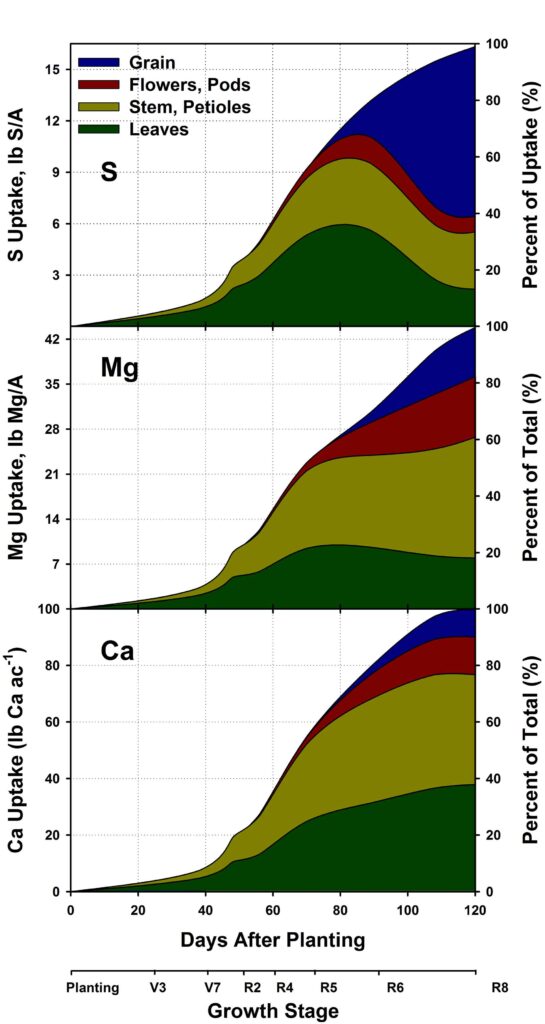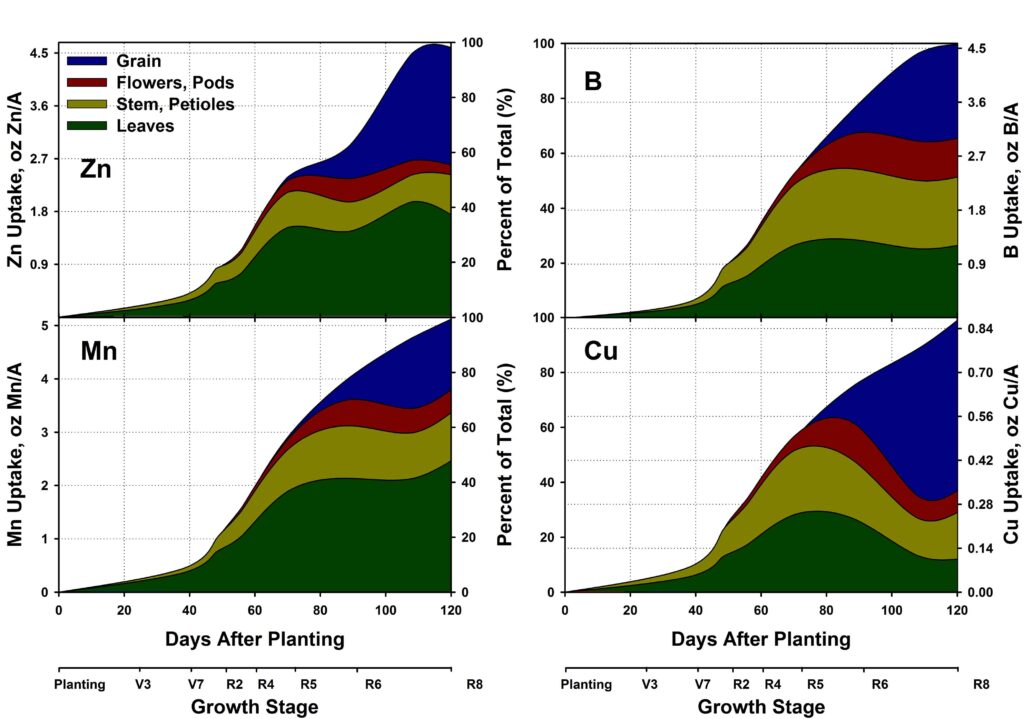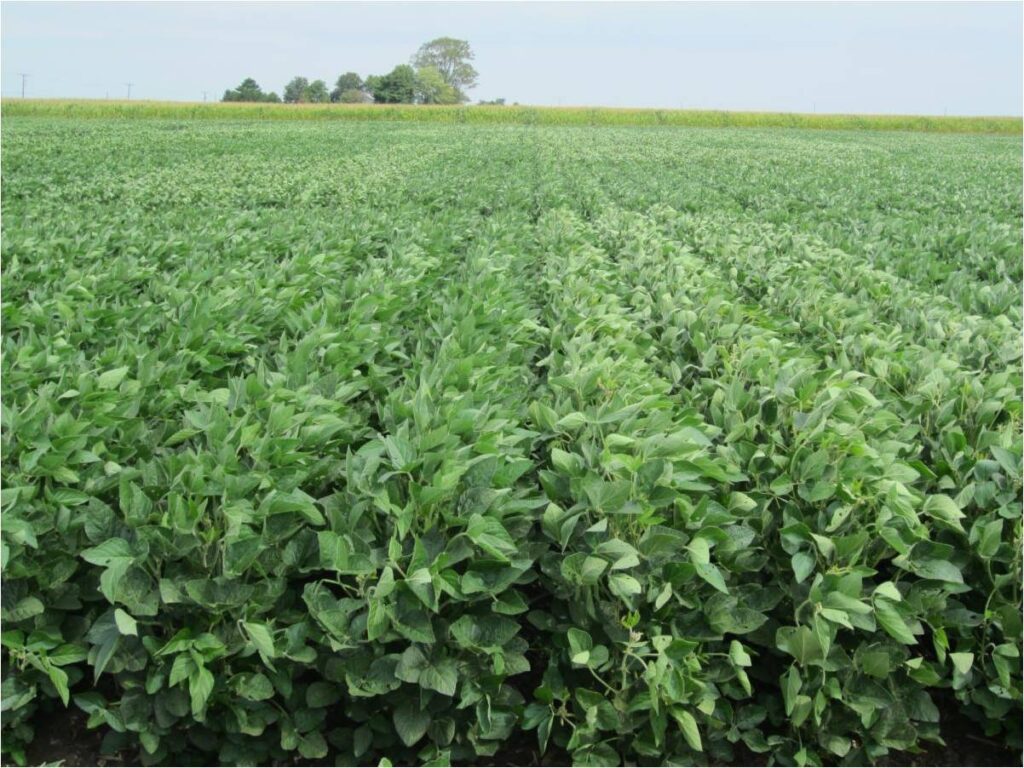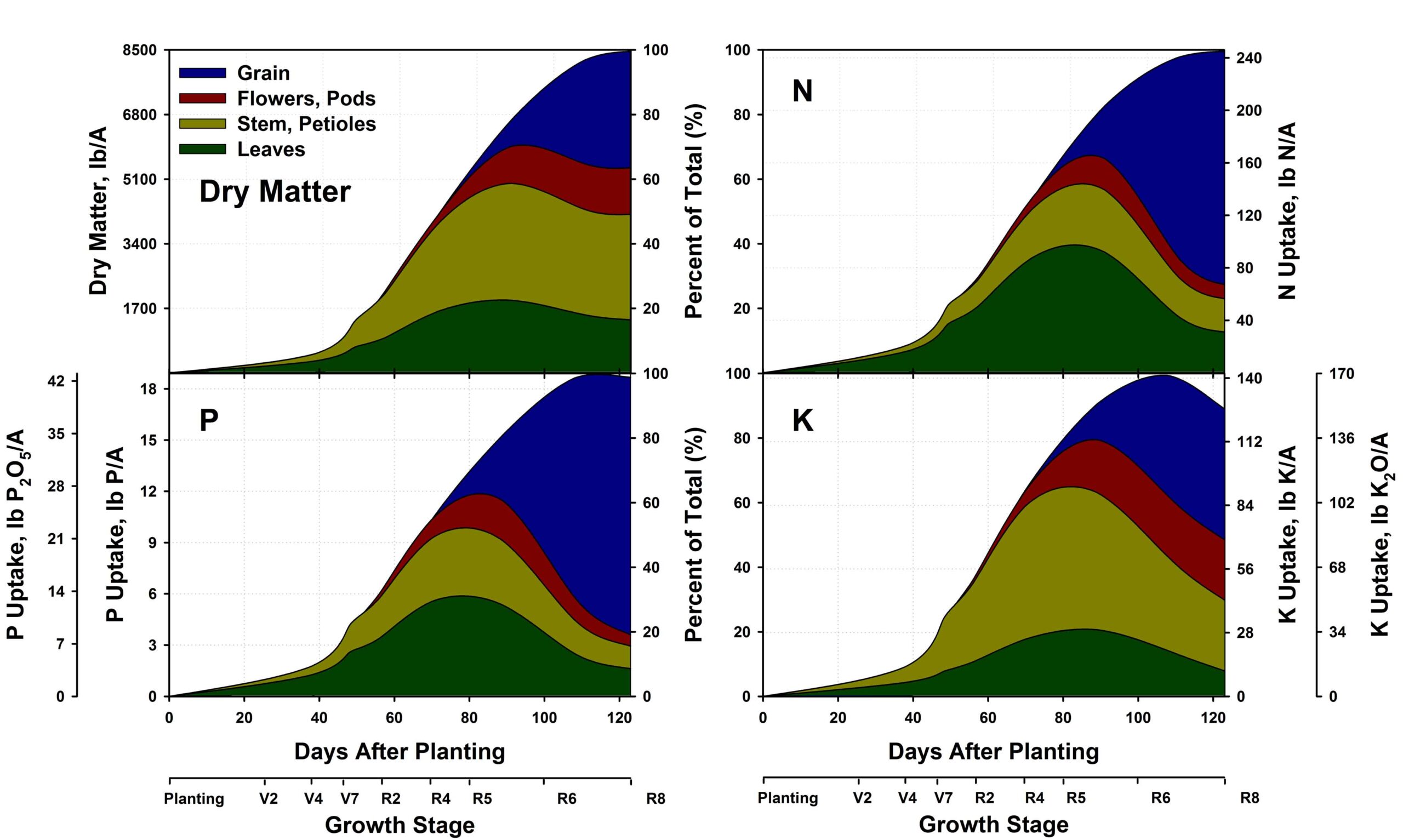Highlights from Soybean Uptake Studies
Many soybean fertility recommendations are derived from research conducted during the 1930s to 1970s, and may not be adequate in supporting the nutritional needs of the greater biomass accumulation and seed yield associated with current soybean germplasm and production systems. Furthermore, no recent data exist that document the cumulative effects of improved soybean varieties, fertilizer source and placement technologies, and plant health/plant protection advancements on the rate and duration of nutrient accumulation in soybean. A more comprehensive understanding of soybean’s nutritional requirements may be realized through this evaluation of the season-long uptake, partitioning, and remobilization patterns in soybean.
The study was conducted at DeKalb (2012 and 2013) and Champaign, IL (2013) using sites maintained in a corn-soybean crop rotation. A 2.8 relative maturity (RM) and 3.4 RM variety were planted at each site to achieve a final stand of approximately 145,000 plants/A. A fertility treatment included 75 lbs P2O5/A as MicroEssentials® SZTM (12-40-0-10S-1Zn) (The Mosaic Company, Plymouth, MN) banded below the soil surface immediately before planting and 60 lbs K2O/A as muriate of potash (0-0-60) broadcast and incorporated before planting (2013 only), collectively, and was compared to an unfertilized control. Dry matter (DM) production and accumulation of nitrogen (N), phosphorus (P), potassium (K), sulfur (S), magnesium (Mg), calcium (Ca), zinc (Zn), boron (B), manganese (Mn), and copper (Cu) was determined at seven incrementally-spaced growth stages: V4 (fourth trifoliate), V7 (seventh trifoliate), R2 (full bloom), R4 (full pod), R5 (beginning seed), R6 (full seed), and R8 (full maturity) (Pedersen, 2009). Each plant was separated into stem (stems and petioles), leaf (individual leaves), reproductive (flowers and pods), and grain tissue components. All data are reported on DM basis (0% moisture concentration).
Averaged across 3 site-years and corresponding treatment combinations, mean biomass and grain yield were 8,256 lbs DM/A and approximately 60 bu/A (13% grain moisture concentration), respectively. The longer RM variety tended to produce greater biomass (+4% to 10%) relative to the shorter RM variety; however, the presumably more adapted variety (i.e., 2.8 RM in DeKalb and 3.4 RM in Champaign) out-yielded its less-adapted counterpart in each comparison. The fertility treatment resulted in an increase in total DM (+9%) and grain yield (+3%) and therefore greater nutrient accumulation. Because DM allocation and nutrient partitioning to these plant tissues were similar across fertility and varietal differences, nutrient accumulation was averaged across treatments in the data presented.
Agronomic production practices and soil conditions with a capacity to supply nutrients at the listed quantities in Table 1 would be expected to meet soybean nutritional needs for an average yield level of approximately 60 bu/A. The potential for nutrient accumulation in soybean has increased by two- to three-fold during the past 80 years as a result of increased DM production and grain yield (Borst and Thatcher, 1931). Mean grain yield values presented in this study are approximately 30 to 40% greater than the current United States average (USDA-NASS, 2014) and the presented nutrient accumulation information may serve as a resource for anticipated improvements in soybean yield.

Biomass production, grain yield, and, for some nutrients, harvest indices have risen during the last 80 years, resulting in concurrent increases in nutrient accumulation. Patterns of biomass production and nutrient accumulation are presented for an average yield of approximately 60 bu/A and are most suitable for producers targeting this yield level. Although nutrient acquisition was most rapid between R3 to R4 for measured nutrients, patterns of nutrient accumulation revealed intra-seasonal differences in the timing of nutrient acquisition. Uptake of K primarily occurred during late vegetative and early reproductive growth in contrast to uptake patterns of N, P, S, Mg, Ca, Zn, B, Mn, and Cu, which were more evenly distributed throughout the entire growing season.
During seed-filling, grain tissues acquired nutrients through remobilization and season-long nutrient accumulation. Four nutrients had harvest index values greater than 60%: P (81%), N (73%), Cu (62%), and S (61%), reinforcing the need for an adequate nutrient supply during reproductive growth.

Biomass production, grain yield, and, for some nutrients, harvest indices have risen during the last 80 years, resulting in concurrent increases in nutrient accumulation. Patterns of biomass production and nutrient accumulation are presented for an average yield of approximately 60 bu/A and are most suitable for producers targeting this yield level. Although nutrient acquisition was most rapid between R3 to R4 for measured nutrients, patterns of nutrient accumulation revealed intra-seasonal differences in the timing of nutrient acquisition. Uptake of K primarily occurred during late vegetative and early reproductive growth in contrast to uptake patterns of N, P, S, Mg, Ca, Zn, B, Mn, and Cu, which were more evenly distributed throughout the entire growing season.
During seed-filling, grain tissues acquired nutrients through remobilization and season-long nutrient accumulation. Four nutrients had harvest index values greater than 60%: P (81%), N (73%), Cu (62%), and S (61%), reinforcing the need for an adequate nutrient supply during reproductive growth.
This study has been published as
Bender, R.R., J.W. Haegele, and F.E. Below. 2015. Nutrient Uptake, Partitioning, and Remobilization in Modern Soybean Varieties. Agron. J. 107:563-573. [open access article] and in per acre units in Better Crops Bender, R.R., J.W. Haegele, and F.E. Below. 2015. Modern Soybean Varieties’ Nutrient Uptake Patterns. Better Crops with Plant Food 99(2) 7-10. [open access article]
The authors wish to thank The Mosaic Company for their financial support of this research.


